Anosike Nnamdi Benedict, Dara Jude Ezechi, Umeobi Happiness Ijeoma, Agu Paul Tochukwu
Department of Mechanical Engineering, Nnamdi Azikiwe University, Awka, Nigeria
Correspondence to: Dara Jude Ezechi, Department of Mechanical Engineering, Nnamdi Azikiwe University, Awka, Nigeria.
| Email: |  |
Copyright © 2021 The Author(s). Published by Scientific & Academic Publishing.
This work is licensed under the Creative Commons Attribution International License (CC BY).
http://creativecommons.org/licenses/by/4.0/

Abstract
Lecterns are essential tools in presentations that provide structure for presenters to boost their confidence. The available lecterns in the university classrooms are not height adjustable and are without in-built presentation aid hence it requires the use of a third party computer and as such has failed to satisfy all the users’ choice. With the aid of a Quality Function Deployment technique, the users’ choice were analyzed and rated. With the ratings we desire to create a system that can accommodate the needs of all people, with or without disabilities. It should make the individual as independent as possible with as few adaptations possible, while maintaining a high level of functionality and grandeur. This report details the entire design process that was used to develop the manually adjustable lectern with electronic presentation aid. The main function of the final lectern design that allows it to accommodate the widest range of users is its height adjustability. It can adjust to heights ranging from approximately 113mm to 1336mm. Additional features designed to accommodate the needs of the user include a tilt adjustable touch screen presentation aid. The developed lectern improved both students’ performance and lecturer’s syllabus content coverage. Students in year five had average performance of 96% in practical course representing 37.1% compared with their performance using the conventional lectern.
Keywords:
Interactive lectern, Adjustable stand, Function deployment approach, Spark software
Cite this paper: Anosike Nnamdi Benedict, Dara Jude Ezechi, Umeobi Happiness Ijeoma, Agu Paul Tochukwu, Development of Interactive Lectern Using Quality Function Deployment Approach, International Journal of Materials Engineering , Vol. 11 No. 2, 2021, pp. 13-19. doi: 10.5923/j.ijme.20211102.01.
1. Introduction
Over the years, wooden, metal (in some cases), glass non-adjustable lecterns have been used for the delivery of lectures, seminars and conferences in the learning and training environments. Most of these lecterns are not electronic and hence not user interactive, ergonomically, they have also been found wanting as they are designed basically for the average height and not considering the varying heights of the users. Lecterns need to be designed to accommodate the widest range of individuals. A standard lectern often used during presentations as revealed by lectern manufacturers showed that for twelve different fixed height lectern models, the average height is about 46 inch (116.84cm) [1]. The Quality function deployment (QFD) technique was employed to develop a house of quality which reveals how users’ needs can be translated into measurable quantities which can be applied in the design process to improve the most prevalent type of lecterns seen in the seminar and learning environment. QFD continues to be a popular tool and has been referred to as “one of the most useful techniques in total quality management [2]. Quality function deployment (QFD) as a system assure that customer needs drive the product design and production process. Quality Function Deployment (QFD) is one method for developing customer oriented products [3]. It translates customers’ needs into product development requirements which ultimately meets these needs [4]. Also employed in the new design is touch sensitive screen equipped with spark software that translates the inscriptions on the lectern onto projected screen display. As we know digital pen technology can potentially support the handwriting process [5] Thus, with a touch-sensitive screen, it is possible to process input signals using physical writing tasks [6]. In other words, digital writing tools improved and perform better than analog tools [7].
2. Method
2.1. Quality Function Development (QFD)
The Quality function development method was used to determine the relationship between each identified need and the corresponding technical measure. A research was carried out and the relative needs of lectern users were analyzed with respect to the possible technical measures that could be applied in view of improving the already existing lecterns. The QFD process involves four phases:Phase 1: transformation of identified needs into product design attributes regarded as technical measures; Phase 2: transformation of important technical measures into parts characteristics;Phase 3: transformation of important parts characteristics into process operations;Phase 4: finally, transformation of process operations into production requirements. The first phase of QFD, usually called house of quality (HOQ), is of fundamental and strategic importance in the QFD system, since it is in this phase that the customer needs for the product are identified and then, incorporating the producing company’s competitive priorities, converted into appropriate technical measures to fulfil the needs. In other words, HOQ links the “voice of the customer” to the “voice of the technician” through which process and production plans can be developed in the other phases of the QFD system.In the HOQ process the correlation matrix of customer needs was obtained. This matrix contains the correlation between each pair of customer needs through empirical comparisons. The information is provided by customers and is quite difficult to obtain since a lot of pairwise comparisons were involved. The purpose of completing this correlation matrix is to identify where trade-off decisions and further research may be required. Correlation is usually described by 5-point scale (very low, low, moderate, high, and very high) which can reveal the customers’ choice in their degree.From research carried out the following customers’ needs (WHATs) were obtained:W1 ShorterW2 Electronic with presentation aidsW3 Good angle of work surface W4 AttractiveW5 Easy to operate and handleW6 DurableW7 ReliableW8 Cheap W9 Light weightTable 1. Four customers’ perceptions on the relative importance of the 9 WHATs
 |
| |
|
These relative importance ratings were computed by taking the average of the customers’ needs. Next is to identify competitors and conduct customer competitive analysis. Competitors in this context refer to other lectern patterns existing in the market.From table 2 the relative importance ratings were scaled between 1 – 7 to represent 5, 5.5, 6, 6.5, 7, 7.5, 8 and entered in the customer importance column in figure 1. Afterwards these technical quantities were matched with the various customers’ needs (WHATS) the relationships that exists between the HOWS and WHATS were rated, some have weak relationships (1) while others have strong relationships (9) there are some whose relationships are neither weak nor strong they were rated 5.Table 2. Relative importance ratings of the 9 WHATs based on the four customers’ perceptions
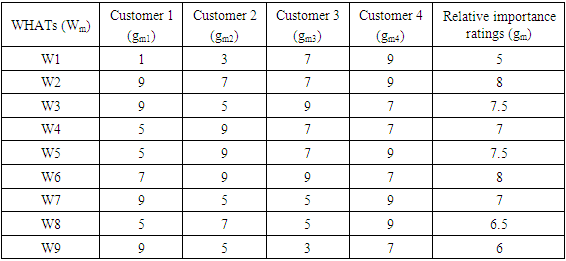 |
| |
|
 | Figure 1. Computer Aided Design of the Lectern |
In the column for customers’ ratings, the various lecterns existing in the market were considered and afterwards rated (1-5) to see how close they come in meeting the customers’ needs. The already existing lectern which is the wooden lectern was marked across to indicate the current level of performance with respect to other lecterns. The lecterns were also rated (1-5) to determine how close each comes towards meeting the engineering technical measures (HOWS). The wooden lectern was also marked across to indicate the current level of performance with respect to other lecterns. The importance ratings were obtained; since the importance rating is a function of how the needs relate to the technical measures they can be easily be obtained by multiplying the customers importance by the relationship strength and adding up. With the information provided so far in the House of Quality, the optimum quantities that will satisfy the technical measures were determined through design analysis and safety requirements where necessary.
2.2. Computer Aided Design and Working Drawing
The design was carried out with the aid of CAD software (solidworks) this is to enable us to view the device structures in three dimensions and conduct possible simulations. When carrying out this analysis, the materials, manufacturing processes, ergonomic attributes, cost implications and aesthetic values which are required before the product design were carefully considered. The working diagram was prepared showing the dimensions fully with hidden details, this is to facilitate a planned work. The proposed electronic lectern in this work contains the following parts.
2.3. Design Analysis
2.3.1. Design of Column
Consider a fixed column as used, length l = 536mm, mass m = 3.11kg, outer diameter do= 117mm and internal diameter di = 111mm, thickness t = 3mm. we desire to find the crushing load which is critical to the column. Considering that the crushing stress of mild steel is 320N/mm2 and young’s modulus for mild steel is 0.21× 106 N/mm2. Then  | (1) |
 | (2) |
Since this value is less than 40, the column is a short column and Euler’s equation does not hold. Hence, Rankine’s equation which applies for both long and short columns was employed and it is given by; | (3) |
Where P is the crushing loadA is the cross sectional area of the columnLe is the equivalent length = l/2 since it is fixed at both endsK is the least radius of gyration and  and is known as Rankine’s constant
and is known as Rankine’s constant
2.3.2. Calculation for the Centre of Gravity of the Lectern at Different Heights
Stability of the system is highly affected by the position of the centre of gravity of the lectern at different height. The centre of gravity (C.G) of a non-uniform body is given by the equation | (4) |
Where m is the mass of individual parts and x is the distance from the centre of gravity of each part to a datum position (in this case the ground) Now considering the lectern, its parts, mass and their respective distance from their centre of gravity at the lowest position of the screw jack.
2.3.3. Calculation of the Critical Angle for the Various Height of the Lectern
If the lectern tilts beyond the critical angle, it topples and falls. Considering the diameter of the base, the critical angle corresponding to the C.G for every elevation can be determined by simple geometry. Critical angle is reached when the C.G is directly perpendicular to point B as shown figure 2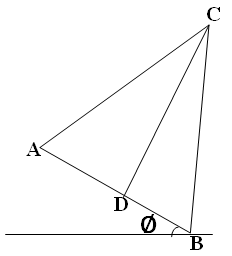 | Figure 2. A system subjected to a critical angle |
3. Results and Discussion
The stability of the lectern is a critical not only a critical issue in the design of the lectern but very in important in its performance. If lectern is not properly design, it could rollover. This might happen when it is tilted to an angle by the use. When a body is tilted, one edge of the base of support becomes a pivot point. As long as the centre of gravity of the box remains over the base of support, torque due to gravity rotates the object back toward its stable equilibrium position; such object is said to be stable. But if the centre of gravity moves outside the base of support, the gravitational torque causes a rotation in the opposite direction. Now the body rolls over; it is unstable. A critical angle is reached when the centre of gravity is directly over the pivot point (fig. 2). This is the point of balance, with no net torque. If the height of the centre of gravity is y, and the width of the base is w, the critical angle is determined by  | (5) |
The developed lectern has adjustable stand to accommodate the wide range of users. These users may include wheelchair users or individuals of varying heights who might find seeing over a lectern difficult due to their height. Workstation ergonomics mean adjusting the furniture and technology to fit the user in the most comfortable, healthy manner. The human physique has many variables. Putting positive ergonomics principles to work can help avert many negative consequences such as back injuries, carpal tunnel syndrome and eye strain. These ergonomics consideration help to improve the users’ morale and productivity.The touch screen presentation aid, in-built into the lectern has made lecturing and presentation quite easy, the adjustability features has also improved the ergonomic demands of the conventional lecture lecterns. After the test for stability, the slope of the graph is quite small hence the change in height only affects the stability to a negligible degree since the maximum critical angle of the lectern at maximum lift of 200mm is 25.6° while the critical angle at no lift is 26.46°; the angular difference is quite small compared to the height difference (fig. 3). This implies that the lectern is only liable to topple and fall when tilted to such degree. The lectern is safe and stable to a good extent. 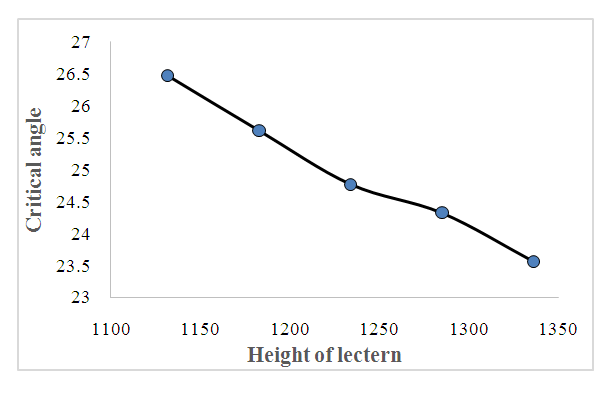 | Figure 3. Critical angle of tilt against various heights of lectern |
Another important design consideration is the buckling of the lectern due to compressive loading. The weight which the lectern was subjected to, was very small and as such, chances of failure of the column due to buckling is almost impossible. The average performance of students in different academic years in a theoretical course was presented in figure 4. The new designed interactive lectern showed relative improvement in the students’ performances. The interactive lectern recorded 4.2%, 6% and 6.8% improvement for students in years one, three and five respectively. It means that more students pay better attention when the lecture delivery is made interactive with the lecturer maintaining constant eye contact with them.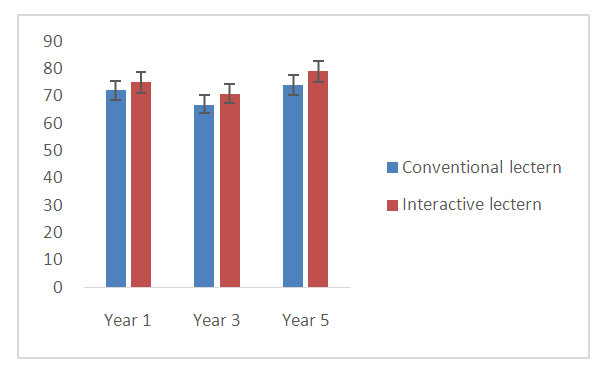 | Figure 4. Comparison of conventional lectern with interactive lectern for a theoretical course |
Figure 5 showed the average performance of students in different academic years in a quantitative course. The developed lectern showed significant improvement in the performances of students. Students in year one recorded the highest success in quantitative course with about 43.3% improvement compared with the conventional lectern. The interactive lectern recorded 33.3% and 31.1% improvement for years three and five respectively. The average performance of students in year five using the developed lectern was 92%. This indicated that the developed lectern aid learning of quantitative course effectively. 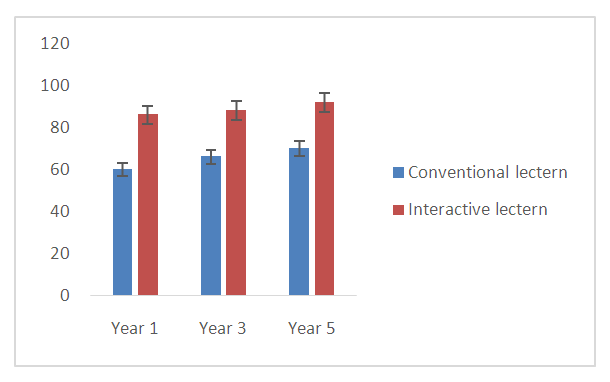 | Figure 5. Comparison of conventional lectern with interactive lectern for a quantitative course |
Figure 6 showed the average performance of students in different academic years in a practical course. Students performed excellently in practical course using the developed interactive lectern. Students in year five had average performance of 96% representing 37.1% compared with their performance using the conventional lectern. The students in year three recorded average performance of 94%, which represent about 44.6% improvement compared with the conventional lectern while the students in year one recorded an average performance of 90% representing about 45.2% improvement.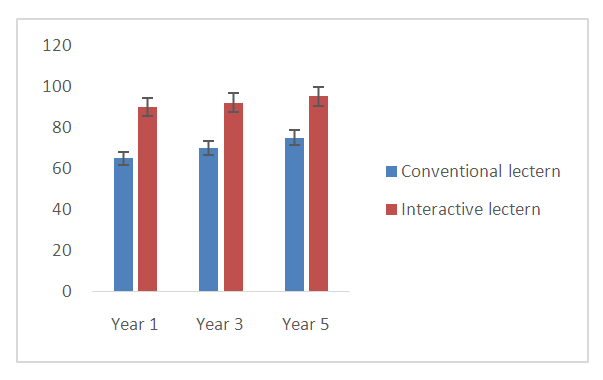 | Figure 6. Comparison of conventional lectern with interactive lectern for a practical course |
Generally, the new developed adjustable interactive lectern improved the average performances of student across different academic levels. Significant improvement in students’ performances were recorded in quantitative and practical courses. The developed lectern offered the students opportunities to follow the thought of the lecturer without unnecessary distractions of backing the students while writing on the board. Also, it helped the lecturer to maintain constant eye contact with the student thereby had better understanding of the non-verbal communications of the students.The effect of the developed lectern on the performance of the lecturer was presented in figure 7. It offered the lecturer greater opportunities to cover the contents of the syllabus especially in practical courses. The time saved in not writing on board and fatigue associated in raising and lowering hands while writing on board is translated to useful time enabling the lecturer to cover more contents. About 98% of practical syllabus were covered using the developed adjustable interactive lectern.  | Figure 7. Percentage completion of syllabus for different course |
4. Conclusions
The lectern was designed to be user interactive to allow for efficient lecture delivery. Also, the height can be adjusted to suit even users on wheelchairs. Quality function deployment approach was able to combine the best features of the already existing lecterns with the user’s needs to design a cheaper lectern that features all the best attributes of these lecterns. This work is very essential to the improvement of learning process and should be adopted by the institution to foster better lecture delivery. Efforts should be made by researchers to device other means of improving learning and developing a highly benefiting classroom layout. Efforts should be made also to improve on the aesthetics and grandeur so that the lectern can also be used in highly profiled auditoriums, churches and so on for presentations, speech, sermon, and lecture delivery.
ACKNOWLEDGEMENTS
This research was supported by the Tertiary Education Trust Fund (TETfund), through Institution Based Research (IBR) grant; years 2012-2014 Merged TETFUND Research Projects (RP) Intervention, 7th Batch, 2017.
Disclosure
This section is ONLY for those who requested disclosure. The name of the experts that reviewed your paper, in case they accepted selling disclosure to you, will appear here. Each reviewer is allowed to make their own price for that, since that is a public endorsement of your findings and may be used for varied purposes.
Appendix
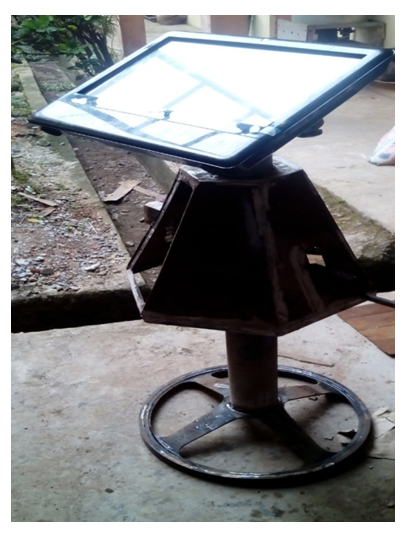 | Figure A1. The developed interactive adjustable lectern |
 | Figure A2. House of quality without roof |
References
| [1] | Canales, T., Sigley, D., Day, S., Sippel, S., & Harding, S. Inclusive Lectern, 2016. |
| [2] | Sullivan LP. “Quality function deployment. Quality progress”, vol. 19 issue 6, pp. 39-50, 1986. |
| [3] | Rosnani Ginting, Aulia Ishak, Alfin Fauzi Malik and M Riski Satrio Product Development with Quality Function Deployment (QFD): A Literature Review IOP Conf. Series: Materials Science and Engineering 1003 (2020) 012022 doi:10.1088/1757-899X/1003/1/012022. |
| [4] | Nadiye Ozlem Erdil and Omid M. Arani, "Quality function deployment: more than a design tool", International Journal of Quality and Service Sciences, 2018. |
| [5] | Anne-Marie Mann, Uta Hinrichs, and Aaron Quigley, “Digital Pen Technology’s Suitability to Support Handwriting Learning” in Tracy Hammond, Stephanie Valentine, Aaron Adler and Mark Payton (Editors), The Impact of Pen and Touch Technology on Education, Springer International Publishing Switzerland, 2015. |
| [6] | Eunil Park, Angel P. del Pobil and Sang Jib Kwon, “Usability of the Stylus Pen in Mobile Electronic Documentation”, Electronics 2015, 4, 922-932; doi:10.3390/electronics4040922. |
| [7] | Saund, E.; Lank, E. Stylus input and editing without prior selection of mode. In Proceedings of the 16th Annual ACM Symposium on User interface Software and Technology, Vancouver, Canada, 2–5 November 2003; pp. 213–216. |







 and is known as Rankine’s constant
and is known as Rankine’s constant 







 Abstract
Abstract Reference
Reference Full-Text PDF
Full-Text PDF Full-text HTML
Full-text HTML


